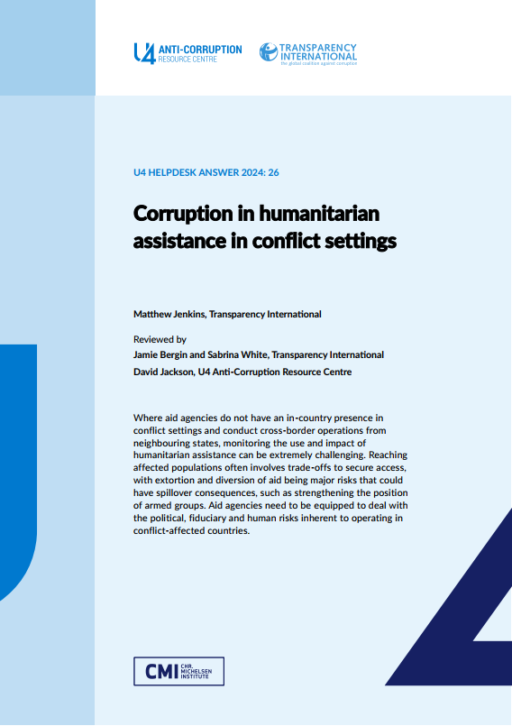
This Anti-Corruption Helpdesk brief was produced in response to a query from a U4 Partner Agency. The U4 Helpdesk is operated by Transparency International in collaboration with the U4 Anti-Corruption Resource Centre based at the Chr. Michelsen Institute.
Query
Please provide an overview of how corruption affects humanitarian aid provided to conflict-affected countries and identify potential safeguards in conditions of remote management.
Summary
Where aid agencies do not have an in-country presence in conflict settings and conduct cross-border operations from neighbouring states, monitoring the use and impact of humanitarian assistance can be extremely challenging. Reaching affected populations often involves trade-offs to secure access, with extortion and diversion of aid being major risks that could have spillover consequences, such as strengthening the position of armed groups. Aid agencies need to be equipped to deal with the political, fiduciary and human risks inherent to operating in conflict-affected countries.
Main points
- Numerous factors make conflict settings arguably the most difficult environment in which to deliver humanitarian assistance. These include denial of access, predatory political economies, acute need, fragmented political landscapes, physical barriers, and the challenges of remote monitoring and international coordination.
- Survey evidence indicates that affected communities perceive corruption to be one of the most pressing issues in humanitarian aid, with aid recipients commonly reporting that corruption, bias and favouritism are major impediments to receiving adequate assistance.
- Nonetheless, the actual incidence of embezzlement, bribery and leakage in humanitarian aid is believed by some experts to be notably lower than perceptions would indicate. The glaring exception is the phenomenon of aid diversion by armed groups. In territories marked by an absent or contested government authority, ‘insurgent taxation’ is commonly levied on all incoming sources of revenue, whether humanitarian assistance, development aid, private investment or community generated resources. Likewise, in regime-controlled areas, authorities have often proven adept at manipulating and co-opting the flow of humanitarian aid. This has been extensively documented in government territories in Syria.
- Corruption risks are likely to materialise during the process of negotiating access to at-risk populations as well as during all stages of the delivery chain. Prominent forms of corruption include extortion and diversion by armed groups, interference in the registration of beneficiaries, unethical procurement practices, embezzlement during transportation and storage of relief goods, and sexual corruption.
- Different delivery models can be considered by aid agencies, with the riskiest involving arrangements with parties to the conflict, such as government agencies or insurgent forces. There is growing evidence that even in conflict zones, channelling aid through local NGOs and community based models can be effective. Nonetheless, each delivery model entails its own specific set of risks, and the role of intermediaries and informal networks should not be overlooked.
- Various mitigation measures can help aid agencies reduce the risk that the cross-border humanitarian aid they provide is misappropriated by corrupt actors or abused in a way that fuels violence. These include both technological techniques, such as the use of GPS tracking, satellite imagery, GIS systems and blockchain, as well as more traditional oversight approaches, third-party monitoring, grievance mechanisms and organisational capacity building.
Contents
- What is at stake in humanitarian assitance?
- Specific corruption risk factors for humanitarian assistance in conflict zones
- Corruption, humanitarian assistance and conflict
- Aid modalities in conflict zones
- Forms of corruption affecting humanitarian assistance in conflict settings
- Typology of humanitarian aid delivery models
- Potential safeguards
- References
Caveat
This Helpdesk Answer focuses on corruption during the distribution of humanitarian assistance in conflict zones once these resources leave an aid agency. As such, the paper does not consider organisational corruption risks that could affect aid agencies, such as malpractice during the agency’s acquisition of goods and services outside of the conflict zone, unethical practices by agency leadership or undue influence over the agency’s internal decision-making. A comprehensive view of both internal and external corruption risks in humanitarian operations more generally is provided by Hees et al. (2014).
For aid agencies attempting to deliver humanitarian assistance to populations in conflict zones, addressing corruption is only one part of a bigger picture. Related considerations include the selection of appropriate aid modalities and delivery mechanisms, identifying suitable in-country partners, negotiating access with armed actors including non-state groups, establishing the needs of affected populations and providing them with a degree of downward accountability. For a broader analysis of how to deliver quality humanitarian assistance in conflict settings, see a study by Haver and Carter (2016) assessing what worked in Afghanistan, Somalia, South Sudan and Syria.
Finally, the Helpdesk Answer also does not consider how measures to tackle corruption in humanitarian aid could fuel violence, or how aid agencies can mitigate this risk.
Authors
Matthew Jenkins, Transparency International
Reviewers
Jamie Bergin and Sabrina White, Transparency International
David Jackson, U4 Anti-Corruption Resource Centre
Date
11/06/2024

